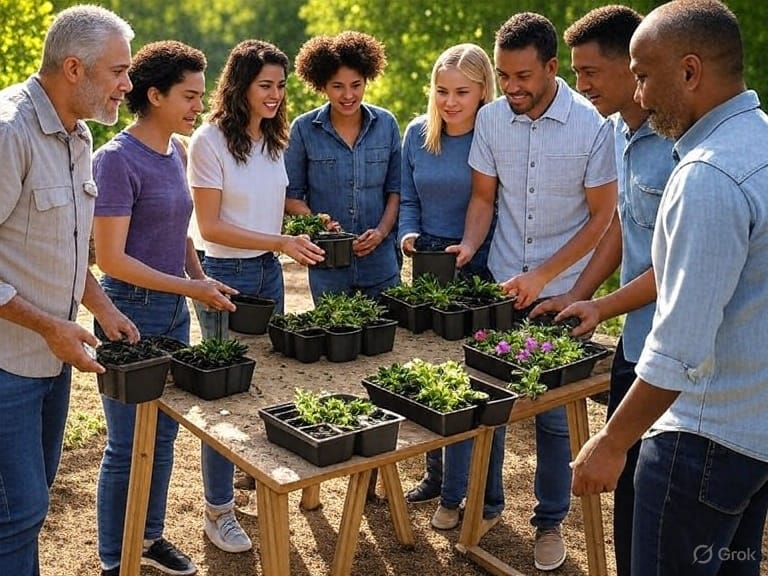Thrive Together
True self-reliance isn’t about isolation—it’s about building a community where shared skills, traded resources, and mutual support empower everyone to thrive.

In a world that often emphasizes individual achievement, the idea of self-reliance can feel like a solitary pursuit. However, true resilience doesn’t mean going it alone—it means weaving a strong web of connections that amplify your ability to thrive. Communities built on mutual support, shared skills, and trust are the backbone of sustainable self-reliance. This article dives into the transformative power of community, offering practical insights on forming skill-sharing groups, trading resources, and fostering networks that help you and those around you flourish in any situation.
Why Community Matters for Self-Reliance
Self-reliance is often misunderstood as complete independence, but no one can master every skill or anticipate every challenge alone. A community provides a safety net, a pool of knowledge, and a sense of belonging that bolsters individual and collective strength. When you connect with others, you create a system where resources, skills, and emotional support flow freely, making everyone more resilient.
Consider a simple example: a neighborhood where one person grows vegetables, another repairs tools, and a third knows first aid. Alone, each is limited, but together, they form a robust network capable of meeting diverse needs. This interdependence doesn’t diminish self-reliance—it enhances it by ensuring no one is left vulnerable when faced with unexpected hurdles.
Communities also foster psychological resilience. Knowing you’re part of a group that has your back reduces stress and builds confidence. In times of crisis—whether a natural disaster, economic downturn, or personal setback—a supportive community can mean the difference between struggle and stability.
Forming Skill-Sharing Groups
One of the most effective ways to build a resilient community is through skill-sharing groups. These are organized efforts where members teach and learn from one another, creating a collective knowledge base that benefits everyone.
Identifying Valuable Skills
Start by assessing the skills within your community. They don’t need to be formal or professional—everyday abilities like cooking, sewing, or basic carpentry are just as valuable as advanced skills like electrical work or medical training. Encourage everyone to contribute something, no matter how small it seems. A retiree who knows how to preserve food or a teenager fluent in tech can bring unique strengths to the table.
Organizing Workshops
Once you’ve mapped out the group’s skills, set up workshops or informal gatherings where people can share their expertise. For example, host a Saturday morning session where someone demonstrates how to repair a bicycle, followed by a canning tutorial. Keep these events accessible—use local spaces like community centers, libraries, or even someone’s backyard. The goal is to make learning practical and hands-on.
Creating a Skill Inventory
To sustain the group, maintain a shared inventory of skills and contacts. This could be a simple spreadsheet or a private group chat listing who can do what. If someone needs help fixing a leaky pipe or building a chicken coop, they can quickly find the right person. This inventory also helps identify gaps—maybe no one knows how to install solar panels, prompting the group to seek out training together.
Skill-sharing groups thrive on reciprocity. When everyone contributes, no one feels like they’re taking too much or giving too little. Over time, these groups build trust and camaraderie, laying the foundation for deeper collaboration.
Trading Resources for Mutual Benefit
Beyond skills, communities can share tangible resources—tools, supplies, or even time. Trading resources reduces waste, saves money, and ensures everyone has access to what they need without relying solely on external systems.
Setting Up Resource Exchanges
A resource exchange can be as simple as a group chat where people post what they have or need: “I’ve got extra lumber—anyone want to trade for some garden tools?” For larger communities, consider organizing swap meets where people bring items to trade, from seeds to books to spare parts. These events are also great opportunities to connect and build relationships.
Establishing Tool Libraries
For items that are expensive or rarely used, like power tools or camping gear, a community tool library is a game-changer. Members contribute tools to a shared pool, and anyone can borrow them as needed. Set clear rules for borrowing and returning items to keep things fair. A tool library not only saves money but also encourages collaboration—someone borrowing a drill might end up helping the lender with a project.
Sharing Time and Labor
Resources aren’t just physical goods; time and labor are equally valuable. Organize work parties where neighbors pitch in to help with big tasks, like harvesting a garden or repairing a fence. In return, the host might provide a meal or offer their skills later. This reciprocal labor builds trust and ensures no one feels overwhelmed by large projects.
The key to successful resource trading is communication. Use online platforms like group chats or bulletin boards to keep everyone in the loop, but don’t underestimate the power of face-to-face interactions. A quick chat over coffee can spark ideas for trades that a text message might miss.
Fostering a Supportive Community Culture
A community’s strength lies not just in its resources but in its culture. A supportive community is one where people feel valued, heard, and motivated to contribute. Building this culture takes intention and effort, but the rewards are profound.
Encouraging Open Communication
Transparency is the bedrock of trust. Create spaces—whether physical meetups or online forums—where people can share their needs, ideas, and concerns without judgment. Regular check-ins, like monthly potlucks or virtual hangouts, keep the group connected and ensure no one feels left out. When conflicts arise, address them openly with a focus on solutions rather than blame.
Celebrating Contributions
Recognize and celebrate what each person brings to the table. A simple thank-you note for someone who shared their expertise or a shout-out during a meeting can go a long way. Highlighting contributions reinforces the idea that everyone’s role matters, whether they’re teaching a class or lending a shovel.
Building Emotional Resilience Together
Self-reliance isn’t just about practical skills—it’s also about mental and emotional strength. Create opportunities for the community to support each other beyond material needs. This could mean organizing wellness check-ins during tough times, hosting storytelling nights to share experiences, or simply encouraging people to listen to one another. A community that cares about its members’ well-being is one that can weather any storm.
Adapting to Change
Communities evolve, and so do their needs. Be flexible—revisit your group’s goals and structures regularly to ensure they still serve everyone. Maybe the skill-sharing group wants to start a community garden, or the tool library needs better organization. Stay open to new ideas and willing to adjust as circumstances shift.
Overcoming Challenges in Community Building
No community is without its hurdles. Differences in priorities, personalities, or resources can create friction, but these challenges can be managed with patience and strategy.
Balancing Participation
Not everyone will contribute equally, and that’s okay—but resentment can build if a few people feel they’re carrying the load. Encourage participation by making tasks manageable and inclusive. If someone can’t attend a workshop, maybe they can share a skill via video or help organize the next event. Keep the vibe collaborative, not obligatory.
Navigating Conflicts
Disagreements are inevitable, whether over resource allocation or group decisions. Establish clear guidelines early on—like how trades are handled or how disputes are resolved—to minimize confusion. When conflicts arise, mediate with empathy, focusing on shared goals rather than individual grievances.
Scaling Sustainably
As your community grows, so do its complexities. Avoid overextending by keeping the core group manageable and focused. If interest surges, consider spinning off smaller subgroups with specific focuses, like a gardening crew or a tech repair team. These can stay connected to the larger network while operating independently.
The Ripple Effect of Community
When you build a community rooted in mutual support, the benefits extend far beyond your immediate circle. Neighbors inspire neighbors, and soon, other groups may form, creating a broader network of resilience. In times of crisis, these connections become lifelines, proving that self-reliance isn’t about isolation—it’s about interdependence.
Imagine a town where skill-sharing groups, tool libraries, and resource swaps are the norm. A power outage doesn’t spark panic because someone knows how to fix a generator. A food shortage doesn’t overwhelm because gardens are shared. This vision isn’t a fantasy—it’s a reality you can help create, one connection at a time.
Getting Started Today
Building a resilient community doesn’t require grand gestures—it starts with small, intentional steps. Reach out to a neighbor and ask what they’re good at. Host a coffee meetup to brainstorm ideas. Share something you have, whether it’s a skill, a tool, or just your time. Every action plants a seed for a stronger, more connected future.
The power of community lies in its ability to amplify what each of us brings to the table. By fostering networks of mutual support, we don’t just survive—we thrive, together. So, take that first step. Your community is waiting.





